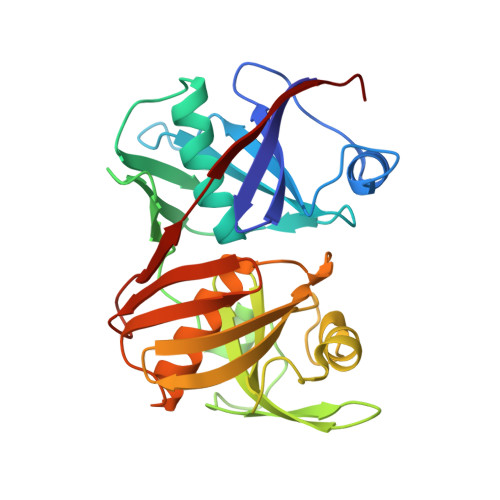Structural insights into stereochemical inversion by diaminopimelate epimerase: An antibacterial drug target.
Pillai, B., Cherney, M.M., Diaper, C.M., Sutherland, A., Blanchard, J.S., Vederas, J.C., James, M.N.(2006) Proc Natl Acad Sci U S A 103: 8668-8673
- PubMed: 16723397
- DOI: https://doi.org/10.1073/pnas.0602537103
- Primary Citation of Related Structures:
2GKE, 2GKJ - PubMed Abstract:
D-amino acids are much less common than their L-isomers but are widely distributed in most organisms. Many D-amino acids, including those necessary for bacterial cell wall formation, are synthesized from the corresponding L-isomers by alpha-amino acid racemases. The important class of pyridoxal phosphate-independent racemases function by an unusual mechanism whose details have been poorly understood. It has been proposed that the stereoinversion involves two active-site cysteine residues acting in concert as a base (thiolate) and an acid (thiol). Although crystallographic structures of several such enzymes are available, with the exception of the recent structures of glutamate racemase from Bacillus subtilis and of proline racemase from Trypanosoma cruzi, the structures either are of inactive forms (e.g., disulfide) or do not allow unambiguous modeling of the substrates in the active sites. Here, we present the crystal structures of diaminopimelate (DAP) epimerase from Haemophilus influenzae with two different isomers of the irreversible inhibitor and substrate mimic aziridino-DAP at 1.35- and 1.70-A resolution. These structures permit a detailed description of this pyridoxal 5'-phosphate-independent amino acid racemase active site and delineate the electrostatic interactions that control the exquisite substrate selectivity of DAP epimerase. Moreover, the active site shows how deprotonation of the substrates' nonacidic hydrogen at the alpha-carbon (pKa approximately 29) by a seemingly weakly basic cysteine residue (pKa approximately 8-10) is facilitated by interactions with two buried alpha-helices. Bacterial racemases, including glutamate racemase and DAP epimerase, are potential targets for the development of new agents effective against organisms resistant to conventional antibiotics.
- Group in Protein Structure and Function, Department of Biochemistry, University of Alberta, Edmonton, AB, Canada T6G 2H7.
Organizational Affiliation:



















